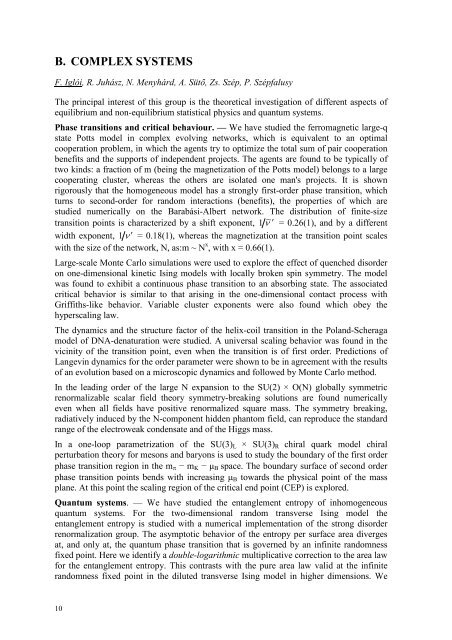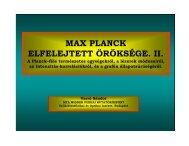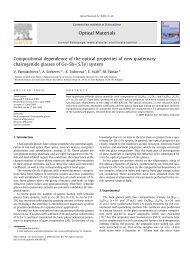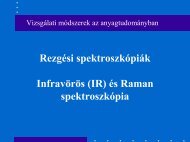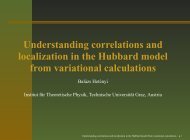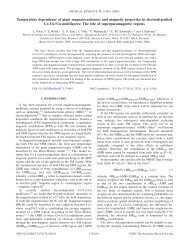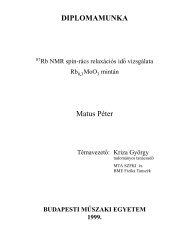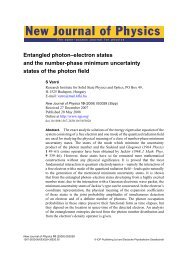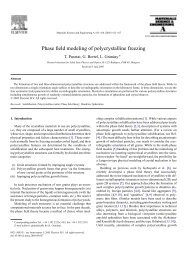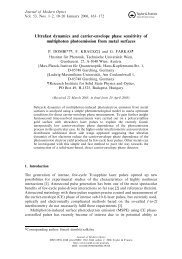ANNUAL REPORT - MTA SzFKI
ANNUAL REPORT - MTA SzFKI
ANNUAL REPORT - MTA SzFKI
You also want an ePaper? Increase the reach of your titles
YUMPU automatically turns print PDFs into web optimized ePapers that Google loves.
B. COMPLEX SYSTEMS<br />
F. Iglói, R. Juhász, N. Menyhárd, A. Sütő, Zs. Szép, P. Szépfalusy<br />
The principal interest of this group is the theoretical investigation of different aspects of<br />
equilibrium and non-equilibrium statistical physics and quantum systems.<br />
Phase transitions and critical behaviour. — We have studied the ferromagnetic large-q<br />
state Potts model in complex evolving networks, which is equivalent to an optimal<br />
cooperation problem, in which the agents try to optimize the total sum of pair cooperation<br />
benefits and the supports of independent projects. The agents are found to be typically of<br />
two kinds: a fraction of m (being the magnetization of the Potts model) belongs to a large<br />
cooperating cluster, whereas the others are isolated one man's projects. It is shown<br />
rigorously that the homogeneous model has a strongly first-order phase transition, which<br />
turns to second-order for random interactions (benefits), the properties of which are<br />
studied numerically on the Barabási-Albert network. The distribution of finite-size<br />
transition points is characterized by a shift exponent, 1 ~ ν ′ = 0.26(1), and by a different<br />
width exponent, 1 ν ′ = 0.18(1), whereas the magnetization at the transition point scales<br />
with the size of the network, N, as:m ~ N x , with x = 0.66(1).<br />
Large-scale Monte Carlo simulations were used to explore the effect of quenched disorder<br />
on one-dimensional kinetic Ising models with locally broken spin symmetry. The model<br />
was found to exhibit a continuous phase transition to an absorbing state. The associated<br />
critical behavior is similar to that arising in the one-dimensional contact process with<br />
Griffiths-like behavior. Variable cluster exponents were also found which obey the<br />
hyperscaling law.<br />
The dynamics and the structure factor of the helix-coil transition in the Poland-Scheraga<br />
model of DNA-denaturation were studied. A universal scaling behavior was found in the<br />
vicinity of the transition point, even when the transition is of first order. Predictions of<br />
Langevin dynamics for the order parameter were shown to be in agreement with the results<br />
of an evolution based on a microscopic dynamics and followed by Monte Carlo method.<br />
In the leading order of the large N expansion to the SU(2) × O(N) globally symmetric<br />
renormalizable scalar field theory symmetry-breaking solutions are found numerically<br />
even when all fields have positive renormalized square mass. The symmetry breaking,<br />
radiatively induced by the N-component hidden phantom field, can reproduce the standard<br />
range of the electroweak condensate and of the Higgs mass.<br />
In a one-loop parametrization of the SU(3) L × SU(3) R chiral quark model chiral<br />
perturbation theory for mesons and baryons is used to study the boundary of the first order<br />
phase transition region in the m π − m K − µ B space. The boundary surface of second order<br />
phase transition points bends with increasing µ B towards the physical point of the mass<br />
plane. At this point the scaling region of the critical end point (CEP) is explored.<br />
Quantum systems. — We have studied the entanglement entropy of inhomogeneous<br />
quantum systems. For the two-dimensional random transverse Ising model the<br />
entanglement entropy is studied with a numerical implementation of the strong disorder<br />
renormalization group. The asymptotic behavior of the entropy per surface area diverges<br />
at, and only at, the quantum phase transition that is governed by an infinite randomness<br />
fixed point. Here we identify a double-logarithmic multiplicative correction to the area law<br />
for the entanglement entropy. This contrasts with the pure area law valid at the infinite<br />
randomness fixed point in the diluted transverse Ising model in higher dimensions. We<br />
10


